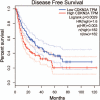p16 Methylation was associated with the development, age, hepatic viruses infection of hepatocellular carcinoma, and p16 expression had a poor survival: A systematic meta-analysis (PRISMA)
- PMID: 28930859
- PMCID: PMC5617726
- DOI: 10.1097/MD.0000000000008106
p16 Methylation was associated with the development, age, hepatic viruses infection of hepatocellular carcinoma, and p16 expression had a poor survival: A systematic meta-analysis (PRISMA)
Abstract
Background: Loss of tumor suppressor gene p16 expression via promoter methylation has been reported in hepatocellular carcinoma (HCC). This meta-analysis was conducted to evaluate the correlation between p16 methylation and HCC. Additionally, we also analyzed the potential prognostic role of p16 methylation, expression or alteration-associated HCC.
Methods: Online databases based on the Preferred Reporting Items for Systematic reviews and Meta-Analyses (PRISMA) guideline were performed to analyze the role of p16 gene in HCC. The combined odds ratios (ORs) or hazard ratios (HRs) and their 95% confidence intervals (95% CIs) were summarized.
Results: Final 3105 HCCs and 808 non-tumor controls (chronic hepatitis and liver cirrhosis) were performed in this meta-analysis. p16 promoter methylation in HCC was significantly higher than in chronic hepatitis and chronic hepatitis in tissue and blood samples. In addition, p16 promoter methylation was notably higher in patients >50 years' old than in patients aged <50 years, and it was higher in hepatitis B virus (HBV) or hepatitis C virus (HCV)-positive HCC than in hepatic viruses-negative HCC. However, p16 promoter methylation was not correlated with sex, cirrhosis, tumor differentiation, clinical stage. No association was found between p16 methylation or alteration and the prognosis of patients with HCC in overall survival (OS) and disease-free survival (DFS). Although p16 expression was significantly correlated with a poor prognosis in OS and DFS (P < .05) CONCLUSIONS:: Our results indicate that p16 methylation was linked to the development, age, HBV, and HCV infection of HCC. p16 methylation or alteration was not associated with the prognosis, but p16 expression was linked to a poor survival.
Conflict of interest statement
The authors report no conflicts of interest.
Figures












Similar articles
-
p16 promoter hypermethylation in human hepatocellular carcinoma with or without hepatitis virus infection.Intervirology. 2004;47(1):26-31. doi: 10.1159/000076639. Intervirology. 2004. PMID: 15044833
-
Differential DNA methylation associated with hepatitis B virus infection in hepatocellular carcinoma.Int J Cancer. 2007 Sep 15;121(6):1257-64. doi: 10.1002/ijc.22849. Int J Cancer. 2007. PMID: 17534893
-
Promoter hypermethylation of p14 (ARF) , RB, and INK4 gene family in hepatocellular carcinoma with hepatitis B virus infection.Tumour Biol. 2014 Mar;35(3):2795-802. doi: 10.1007/s13277-013-1372-0. Epub 2013 Nov 20. Tumour Biol. 2014. PMID: 24254306
-
Relationship between the rs2596542 polymorphism in the MICA gene promoter and HBV/HCV infection-induced hepatocellular carcinoma: a meta-analysis.BMC Med Genet. 2019 Aug 16;20(1):142. doi: 10.1186/s12881-019-0871-2. BMC Med Genet. 2019. PMID: 31419949 Free PMC article. Review.
-
Association of RASSF1A hypermethylation with risk of HBV/HCV-induced hepatocellular carcinoma: A meta-analysis.Pathol Res Pract. 2020 Oct;216(10):153099. doi: 10.1016/j.prp.2020.153099. Epub 2020 Jul 15. Pathol Res Pract. 2020. PMID: 32853942 Review.
Cited by
-
Discovering the mechanism and involvement of the methylation of cyclin-dependent kinase inhibitor 2A (CDKN2A) gene and its special locus region in gastric cancer.Bioengineered. 2021 Dec;12(1):1286-1298. doi: 10.1080/21655979.2021.1887646. Bioengineered. 2021. PMID: 33896386 Free PMC article.
-
DNA methylation drives a new path in gastric cancer early detection: Current impact and prospects.Genes Dis. 2023 Mar 30;11(2):847-860. doi: 10.1016/j.gendis.2023.02.038. eCollection 2024 Mar. Genes Dis. 2023. PMID: 37692483 Free PMC article. Review.
-
The innovative regularity and role of p16 methylation in blood during HCC development.J Cancer. 2018 Apr 27;9(11):1925-1931. doi: 10.7150/jca.23968. eCollection 2018. J Cancer. 2018. PMID: 29896276 Free PMC article.
-
Role of Virus-Induced Host Cell Epigenetic Changes in Cancer.Int J Mol Sci. 2021 Aug 3;22(15):8346. doi: 10.3390/ijms22158346. Int J Mol Sci. 2021. PMID: 34361112 Free PMC article. Review.
-
Cell-free methylation of RASSF1 and CDKN2AIP genes in the diagnosis of hepatocellular carcinoma associated with hepatitis B virus cirrhosis.Hepatol Forum. 2022 Sep 23;3(3):77-81. doi: 10.14744/hf.2022.2022.0021. eCollection 2022 Sep. Hepatol Forum. 2022. PMID: 36177104 Free PMC article.
References
-
- Torre LA, Bray F, Siegel RL, et al. Global cancer statistics, 2012. CA Cancer J Clin 2015;65:87–108. - PubMed
-
- El-Serag HB, Rudolph KL. Hepatocellular carcinoma: epidemiology and molecular carcinogenesis. Gastroenterology 2007;132:2557–76. - PubMed
-
- Arzumanyan A, Reis HM, Feitelson MA. Pathogenic mechanisms in HBV- and HCV-associated hepatocellular carcinoma. Nat Rev Cancer 2013;13:123–35. - PubMed
-
- El-Serag HB. Hepatocellular carcinoma. N Engl J Med 2011;365:1118–27. - PubMed
Publication types
MeSH terms
LinkOut - more resources
Full Text Sources
Other Literature Sources
Medical

